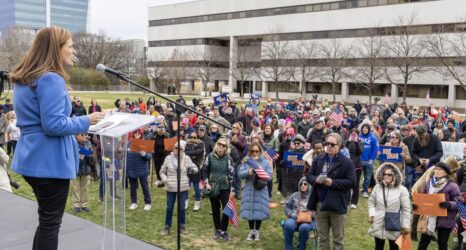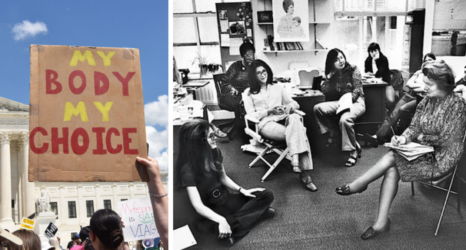Clayton’s strategy for revitalizing the Democratic Party in North Carolina is to expand the party’s base by focusing on young voters and rural communities.
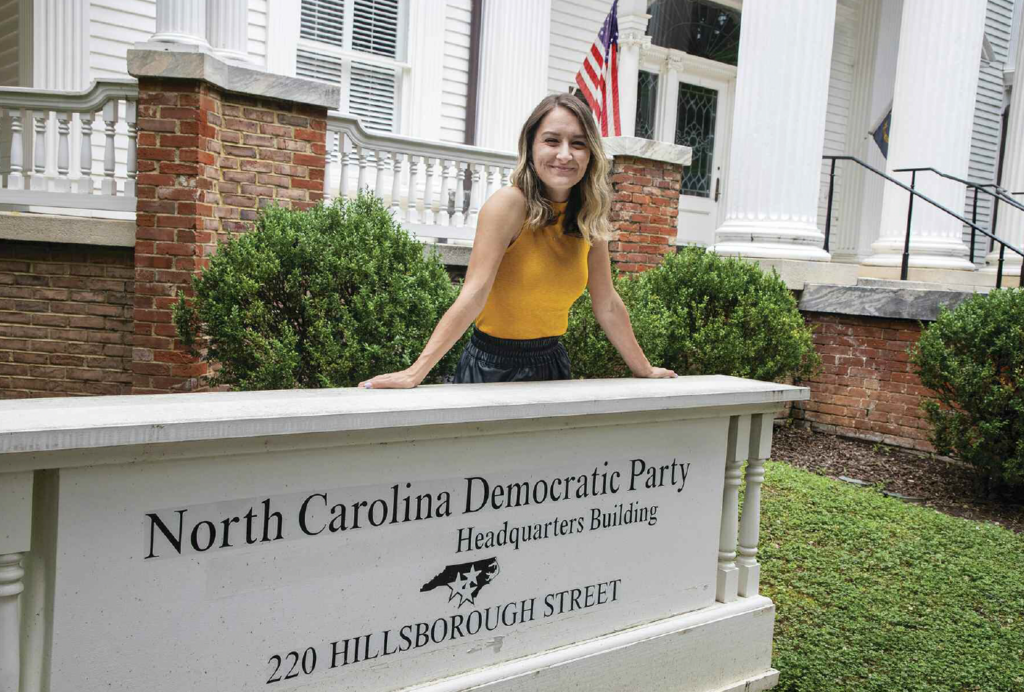
The headquarters of North Carolina’s Democratic Party calls to mind times gone by, the stately, neoclassical mansion conjuring up visions of lazy summer evenings amid the sweet scent of magnolias. But the Goodwin House’s new inhabitant is anything but old-fashioned—25-year-old Anderson Clayton is gritty rather than stately, a woman on a mission, dissatisfied with the status quo, fiercely determined and keen to revitalize her party.
In February, Clayton ousted Bobbie Richardson—a woman 48 years her senior who was endorsed by the North Carolina Democratic establishment, including Gov. Roy Cooper—to become the youngest party chair in the nation. The upset surprised even Clayton.
“I ran for state party chair, not expecting to win anything,” she told Ms. “It was more about putting up a fight. Regardless of what you think of me, you know I am a fighter and will take on any injustice I see.”
Clayton is not timid about voicing her opinions on politics in general and the state Democratic Party in specific. When she speaks about injustices, she is alluding to what she calls the “money-driven” culture of politics and self-centered ambition that turns off people who are committed to the common good, especially, she said, “those who operate in the activist and organizing space. People who see politics as improving lives write off the N.C. Democratic Party as a party of power grabbers or people who want to make it somewhere. … Party politics is not about being a public servant anymore. It is about being a politician.”
Clayton’s own introduction to politics began at Appalachian State University, where she became involved with the Democratic Party by registering students to vote. After that, she worked on North Carolina Rep. Kathy Manning’s campaign for the U.S. House. And in 2020, she jumped into national politics, working as a staffer on the presidential campaigns of both now-Vice President Kamala Harris and Massachusetts Sen. Elizabeth Warren.
Clayton’s strategy for revitalizing the Democratic Party in North Carolina—a battleground state in the upcoming 2024 elections—is to expand the party’s base by focusing on young voters and rural communities, which she believes the party has ignored for far too long.
North Carolina has a substantial rural population, second only to Texas. Yet according to Clayton and a myriad of news reports, the Democrats have all but ceded this voting bloc. Clayton believes the party needs an economic plan to win back these communities.
The people there “are just trying to figure out how to get a good job,” she said. “‘How do I get a roof over my head? How do I take care of myself tomorrow?”
Clayton said her plan calls for putting a “party representative in all of North Carolina’s 100 counties, introducing an economic plan for rural communities who now struggle to simply survive, organizing year-round, building a party infrastructure and fielding more and better candidates for public office. And we need to demonstrate that we care about people nobody else has cared about.”
Clayton wants the party to articulate concerns and provide solutions rather than just, say, reiterating the causes of inflation or explaining how the pandemic created supply problems. “I just don’t think most voters are actually thinking about what are the factors that are driving up costs. I think they are reeling from how expensive everything is”—and they want to know what will be done about it, she notes.
While recapturing the rural vote is central to Clayton’s blueprint to rebuild the state party, North Carolina’s long history of partisan gerrymandering— drawing district lines that favor one party over another—looms large on the political landscape.
It’s “the most gerrymandered state in the country,” she said.
Political experts, including Hannah Wheelen, a senior analyst with the Princeton Gerrymandering Project, echo this statement. In a 2021 interview with the Chatham News + Record, she said, “What’s happening in North Carolina right now is a unique case of opportunity and intent. In most states, when there’s a slight bit of partisan control, there’s probably a little bit of an intent to use power to draw lines. But in North Carolina, we don’t see a lot of mechanisms that in states block it from getting out of control.”
For instance, unlike in most other states, the governor does not have the power to veto legislative maps.
A glaring example of the Republican Party’s attempt to draw favorable district lines occurred at North Carolina A&T State University, the nation’s largest historically Black public university. When the Republican-dominated legislature drew congressional district lines in 2016, it divided the university into two separate voting precincts.
Clayton explained the absurdity of the situation: “Five thousand students are on one side in one district, and 5,000 students are on another side. So even when students register to vote on campus, they still have to go to two different polling locations and are told different things on Election Day.”
The situation inevitably wreaked havoc, leaving the A&T students confused and frustrated.
An even more extreme example of partisan gerrymandering can be found in the case Moore v. Harper, which was decided by the Supreme Court earlier this year and represented an outrageous attempt to give the North Carolina legislature the ability to draw congressional lines without judicial oversight. The maneuver is based on the dubious independent state legislature (ISL) theory, which asserts that the U.S. Constitution grants legislatures exclusive, unchecked power over elections in their state.
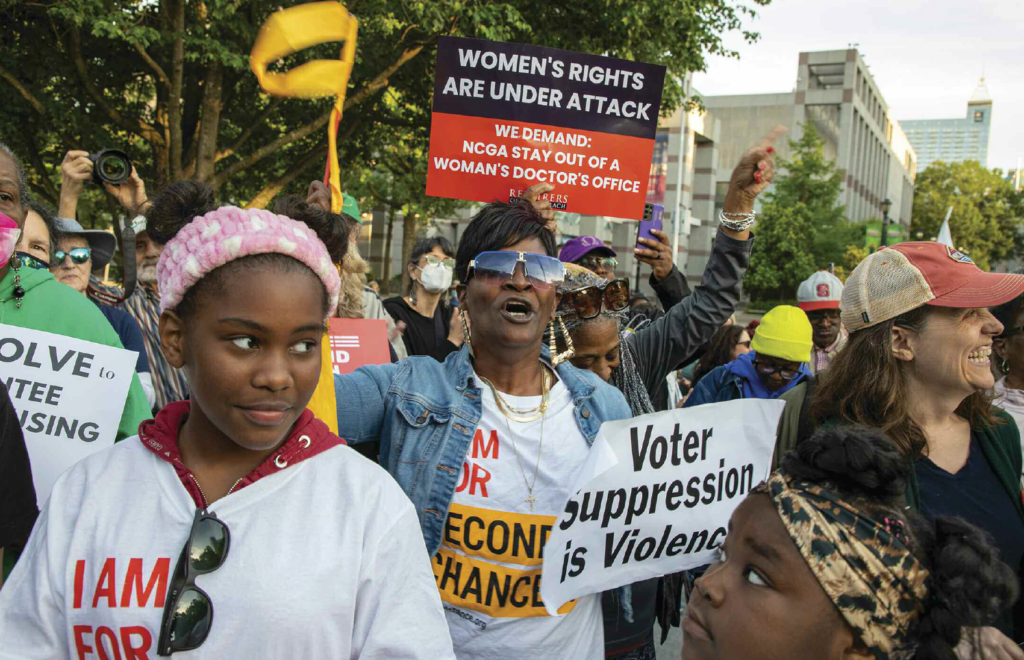
In 2021, the North Carolina Legislature drew a heavily gerrymandered map that allowed state politicians to pick their voters. It guaranteed that Republicans would control 10 out of North Carolina’s 14 U.S. congressional seats, despite the state voting in nearly equal numbers for then-President Donald Trump and his opponent, Joe Biden, in the 2020 presidential election.
The state supreme court struck down the map, ruling that it violated parts of the North Carolina Constitution that ban partisan gerrymandering. Proponents of the ISL theory appealed to the U.S. Supreme Court, which ruled against them.
If the Supreme Court had found in their favor, such a decision also would have granted state legislators total discretion to create and change election laws without checks and balances from state courts, jeopardizing the fairness of elections around the country.
In accordance with the Supreme Court ruling, the North Carolina legislature will redo the district maps in time for the 2024 elections. Still, the new set of lines are likely to be redrawn with the same result as the earlier map—diluting the Black vote, political scientist Michael Bitzer told The News & Observer.
Bitzer predicted the new maps will again give Republicans 10 seats and Democrats four. The current map, created by an impartial mapmaker by order of the state supreme court, gives Republicans and Democrats seven seats apiece.
Considering the fact that Black voters in North Carolina overwhelmingly pick Democrats, the new lines will have to dilute the Black vote, just as before.
“And herein lies the dilemma, particularly in the South, of trying to tease out race in politics. It’s pretty much a no-win situation,” Bitzer concluded.
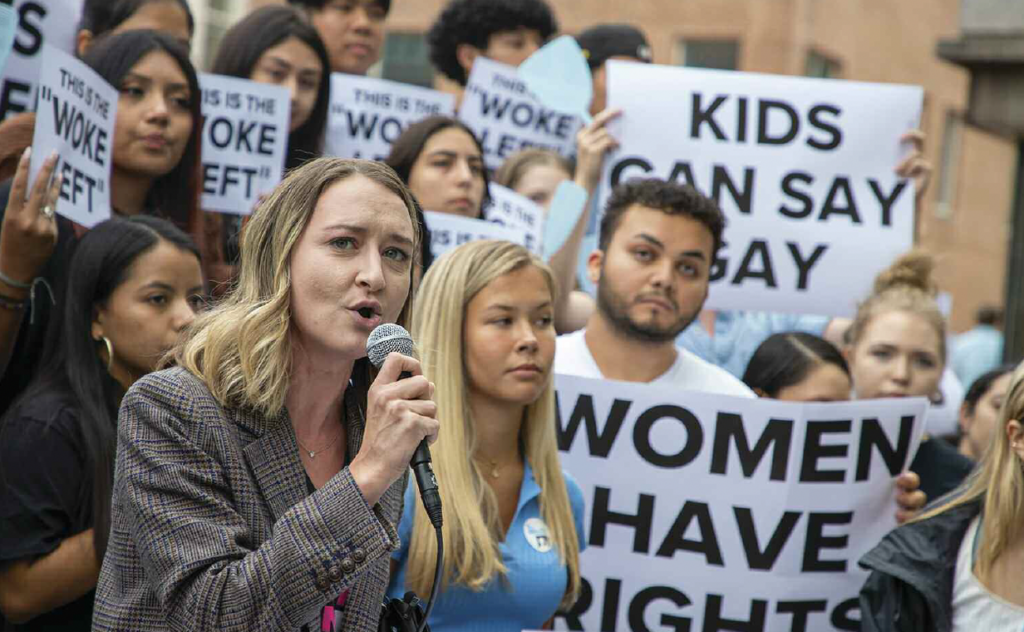
Other voter suppression efforts compound the barriers some communities face in participating in elections.
Starting with the municipal races this September, voters must show a state-issued photo ID to cast their ballot. This means going to the additional step of obtaining the document, and this includes college students. The law also negatively impacts Black Americans, especially older voters, because many don’t have birth certificates, which are required to secure an ID.
Although voter suppression and partisan gerrymandering are entrenched in North Carolina politics, Clayton is confident that her party has a path to victory in 2024. In multiple interviews with the media, she has insisted that winning back rural voters would reap dividends, and organizing young voters would expand Democratic support.

This story originally appeared in the Fall 2023 issue of Ms. magazine. Join the Ms. community today and you’ll get the Fall issue delivered straight to your mailbox.
The potential of young voters to alter the political terrain nationally is enormous.
In 2022, young voters flexed their political muscle by delivering the second-highest midterm turnout for their demographic in three decades. (The highest was in 2018.) Statistics compiled by the Center for Information & Research on Civic Learning and Engagement (CIRCLE) at Tufts University indicate that young voters’ turnout in the 2022 midterms was 27 percent. In North Carolina, it was 23 percent.
Of importance to Clayton, young voters were more likely to vote for the Democratic candidate in a congressional race by a 28-point margin nationally. The highest support for Democratic candidates came from young women (71 percent of whom voted for Democrats), Black youths (87 percent for Democrats) and Latino/a youths (67 percent for Democrats). Overall, 63 percent of young voters cast their ballot for the Democratic House of Representatives candidate, and in North Carolina 52 percent of young voters marked their vote for the Democratic Senate candidates.
The most significant issue driving voters, especially young ones, is the right to abortion—or, rather, the recent loss of this right. Clayton has found abortion to be a mobilizing issue for young people since Dobbs v. Jackson Women’s Health Organization reversed Roe v. Wade. In a June interview with The News & Observer in Raleigh, Clayton said the party has seen “a big boost in fundraising, like in other states where voters faced a threat of reproductive freedom in some way.”
The loss of abortion rights has had a mind-reeling effect on young people—especially young women—who have grown up with Roe v. Wade as a long-standing precedent, set well before their time.
For young voters in 2022, abortion was the top issue determining their vote: Some 44 percent of 18- to 29-year-olds nationwide said it was the most important factor, followed by inflation at a distant 21 percent, according to CIRCLE analysis.
In the Ms. poll conducted just before the midterms across nine battleground states, including North Carolina, 55 percent of young women said abortion and women’s rights combined were the top issues that would determine their votes, and 41 percent of them said they were feeling angry or worried about the Dobbs decision.
While the Dobbs ruling did not make abortion illegal, it did end federal constitutional protection for abortion, enabling state “trigger laws” banning the procedure to immediately go into effect. Today, 15 states have outlawed abortion. North Carolina is among the states that have imposed draconian measures making it nearly impossible to terminate a pregnancy. The legislature banned abortion after 12 weeks of pregnancy, imposed a burdensome 72-hour waiting period after mandatory one-on-one counseling, and prohibited Medicaid coverage of abortion except in limited circumstances.
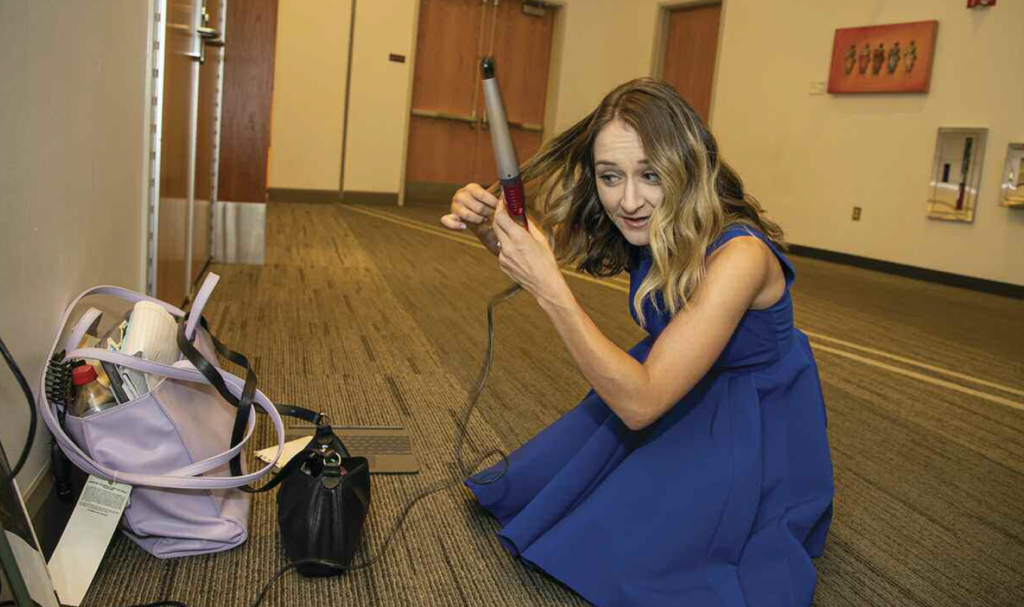
Clayton points to climate change and gun violence as other key topics that mobilize young voters. “We realize we’ve got to live here on this planet for about 50 years, and we don’t know if we can live that long with how things are going,” she said, adding, “It motivates more and more young people to get involved. They know people in charge are not taking action as they should.”
Research bears out Clayton’s contention that young voters’ worries about gun violence are evident across the state and the country. In 2023 the Institute of Politics at Harvard Kennedy School found that “40 percent of young Americans are concerned about being victims of gun violence or mass shootings. One in three are concerned about someone close to them being a victim of gun violence or a mass shooting.” This translates into strong support for stricter gun laws: Some 63 percent of 18- to 29-year-olds favor new legislation.
Clayton is confident that the Democrats’ positions on abortion, climate change and gun violence will give her party a shot in the arm and expand its ranks, especially among young people. She said that building the infrastructure, rebuilding the trust of rural voters, recruiting young voters, consolidating the Democratic base and fielding more candidates for public office would reverse the fortunes of the stagnant state party. “I don’t think we’ve focused on that at all,” she contends.
Her new vision is highly ambitious for a party accustomed to losing in the state House and Senate for the past 13 years, and considering the many Republican efforts to suppress the vote of its core constituents. But Clayton feels a sense of urgency, believing that this election cycle will determine whether Democrats can take back the state in 10 years—or in 20.
Clayton shows no signs that she is not up to the challenge. She credits her drive, boldness and doggedness to the women in her family who had a hand in raising her.
When asked whether she would describe herself as a pragmatist, idealist, politico or feminist, she replied, “I definitely say I’m a feminist.”
Tears welled up in Clayton’s eyes. “I was raised to be a feminist by my mother, a powerful woman. My mom, my sister, my aunt and my cousins are all strong-willed women. I credit my mother with who I am today.”
Musing about how unlikely it was for a kid from a rural part of the state to end up in her position, she added, “That doesn’t happen to a regular 25-year-old. It had to have something about the way you were brought up or something you were taught. I really do think it was my mom. She taught me I could do anything I wanted.”
Up next:
U.S. democracy is at a dangerous inflection point—from the demise of abortion rights, to a lack of pay equity and parental leave, to skyrocketing maternal mortality, and attacks on trans health. Left unchecked, these crises will lead to wider gaps in political participation and representation. For 50 years, Ms. has been forging feminist journalism—reporting, rebelling and truth-telling from the front-lines, championing the Equal Rights Amendment, and centering the stories of those most impacted. With all that’s at stake for equality, we are redoubling our commitment for the next 50 years. In turn, we need your help, Support Ms. today with a donation—any amount that is meaningful to you. For as little as $5 each month, you’ll receive the print magazine along with our e-newsletters, action alerts, and invitations to Ms. Studios events and podcasts. We are grateful for your loyalty and ferocity.




